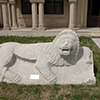Burdur - Archaeology Museum

The ancient monuments in Burdur and its environs were formerly collected by archeologists and conserved in the library building, which is the only remaining building of the historical Bulguroğlu (Pirgulzade) School. The first steps towards the establishment of the museum were thus taken. The opening ceremony of the exhibition halls of Burdur Museum was held in 1969.
Today, Burdur Museum is among the first 10 - 15 museums of Turkey with its 50,000 monuments. The museum, which is very rich in monuments, had initially experienced considerable inadequacy, caused mostly by its lack of space, but has now gained a new identity with its new exhibition halls built in 1998.
Burdur, because of its fortunate geographical location, represents the typical common features of the Mediterranean, Aegean and Central Anatolian civilizations. The findings in the Burdur Museum are the historical and cultural treasury of a history of 9000 years, expanding from B.C. 7000 to this date. Statues, steles, various architectural objects, tombs and tombstones, incomplete inscriptions, high embossments, etc. of Phrygian, Hellenistic, Roman, Byzantine and Ottoman Times are exhibited in the garden of the museum. Almost all of the monuments exhibited in the Statue Hall have been brought from the archaic city of Kremna, within the borders of Bucak District of Burdur, in the 18th century. These monuments include a Great and a Small Athena, Hygieia, Leto, Apollo, Nemesis, Dionysos, Aphrodite as well as generic women statues with cloths, all of high artistic value.
 The ancient monuments in Burdur and its environs were formerly collected by archeologists and conserved in the library building, which is the only remaining building of the historical Bulguroğlu (Pirgulzade) School. The first steps towards the establishment of the museum were thus taken. The opening ceremony of the exhibition halls of Burdur Museum was held in 1969.
The ancient monuments in Burdur and its environs were formerly collected by archeologists and conserved in the library building, which is the only remaining building of the historical Bulguroğlu (Pirgulzade) School. The first steps towards the establishment of the museum were thus taken. The opening ceremony of the exhibition halls of Burdur Museum was held in 1969.